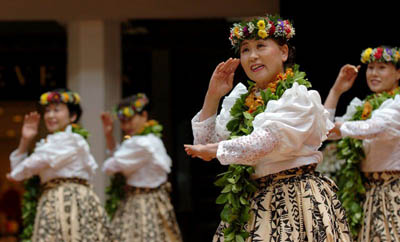Ku Holo La Komohana / Sail On to the Western Sun
Celebrating over 125 years of Historical Connections and Intercultural Exchanges between Hawai'i and Japan
Things Hawaiian in Japan
In the 1960’s as tourism from Japan expanded in Hawai’i, things Hawaiian have grown in popularity in Japan, and things Hawaiian have become a part of Japanese culture. Among two of the most popular aspects of Hawaiian culture transplanted to Japan are hula and Hawaiian music. In 2005, a Honolulu Advertiser article reported that hula halau (schools) are flourishing in Japan and an estimated 300,000-400,000 people were involved in hula. (“Japan hooked on hula,” July 11, 2005).
"Nani Iapani: The First Annual Japan Hula ‘Oni E Festival," held in Tokyo on January 6, 2007. A review by Kihei de Silva, who served as a judge for the competition.
|

Photo: Japanese Hula Dancers, by Rebecca Breyer, Honolulu Advertiser, July 11, 2005.
|
Hawaiian music has been popular in Japan much longer. Keith and Carmen Haugen point out in “Japan & Hawaiian Music” that “Hawaiian music in Japan dates back to 1881 when a Japanese band played “Hawai‘i Pono‘i” at Yokohama Harbor, to welcome … King David Kalakaua. Hawaiian music was performed at the Yokohama World’s Fair in 1923 and was adopted by some musicians in Japan. In the 1930’s, Hawaiian musicians toured Japan. After the disruptions created by World War II, the popularity of Hawaiian music resumed and continues today. There are musicians and clubs dedicated solely to playing Hawaiian music. In the 1970’s, with the revival of Hawaiian music in Hawai‘i led by slack key artists like Gabby Pahinui, slack-key (as opposed to the earlier steel-guitar based music) also became popular in the Japanese musical scene.
|
Hawaiian Songbook, from "Japan & Hawaiian Music."
|
Driving along the coast in Kumano in the summer of 2004, I was surprised to see small crowds of surfers offshore wherever there were breakers. Surfing has spread to the coastal areas of Japan blessed with waves, not just in the southern semi-tropical islands of Okinawa, Kyushu, and Shikoku, but Honshu as well, and even Hokkaido. Some favorite spots on Honshu include Atsumi Peninsula in Aichi Prefecture, Chiba, and Shonan in Kanagawa. The surf isn't at the same level of quality or size as in Hawai'i, but surfers everywhere make the best of what they are given. The best surf is generated by typhoons in the southwestern Pacific during the summer months, when the weather is also hot and the water warm. Surf Japan.com has descriptions of breaks as well as some travel tips. The Outside Japan website hosts a surf columnist, albeit an Australian, not a local (no doubt because the column is written for those who read English).
|
Photo: the Surf at Atsumi, from “Atsumi Peninsula Surf Beaches.”
|
Thing Japanese in Hawai'i
As the Japanese immigrants and their descendants became a integral part of the modern culture of Hawai’i in the 20th century, things Japanese became part of the multicultural landscape of Hawai'i, culural practices like bon dances, lantern ceremonies, and New Year’s mochi pounding, and foods like sashimi, tempura, musubi (rice balls, wrapped in dried seaweed) and shave ice. The Hawaiian writer John Dominis Holt describes in Recollections (1993) a Japanese business household and New Year’s celebration in the multiethnic neighborhood of Kalihi in the early 20th century:
In Kalihi we were plunged into a strange world, multilingual and ethnically diverse. At the other houses where we had lived one never heard the neighbors and rarely saw them; now it was unavoidable for us to see and hear our closest neighbors every day. We came to know extremely well those within an over-all area of six city blocks. Chinese and Japanese families ran the neighborhood stores on King Street and kept small vegetable farms on Kam IV Road. The older members of the Chinese families spoke their native tongue almost exclusively. The great Japanese merchant U. Yamane also had an establishment on King Street. His store was crowded with imports from Japan, canned goods, and pickled vegetables packed in large tubs. I can still see the long radishes colored yellow called takwan being pulled out of their wooden buckets and weighed when purchased. Mr. Yamane was a short, stocky man who came as a merchant with early immigrants from Japan. He was impressive looking, with a short-cropped moustache and short hair. He usually wore grey suits and would remove his coat and tie as the day’s activities progressed. The commodious Yamane home sat facing King Street opposite the family’s variety store. Their yard, the largest in the neighbhood, was filled with fruit trees—mango, avocado, lichee and soursop. Their parties at New Year’s were magnificent affairs where one saw a long, low table groaning with Japanese food specialties. I always marvelled at the boiled or raw carp covered with nets carved from daikon and the Imari platters of sashimi surrounded by “flowers” carved from various vegetables. My father loved those Yamane parties, as the Scotch, bourbon, and sake flowed for most of two days.
“Japanese Traditions” at the Japanese Culture Center of Hawai’i website describes things Japanese in Hawai’i. (The cultural habits and dialects of the immigrants originated in their late 19th and early 20th century rural homelands in Western Honshu, Kyushu and Okinawa; so some local Japanese practices and words that have continued to be used in subsequent generations might strike the young Tokyo traveler today as quaint or curious.)
|
|